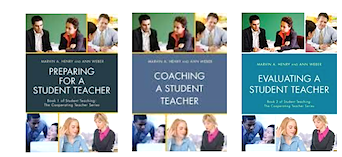A Blueprint for Working with Student Teachers
Preparing for a Student Teacher: Book 1 of Student Teaching
Coaching a Student Teacher: Book 2 of Student Teaching
Evaluating a Student Teacher: Book 3 of Student Teaching
By Marvin A. Henry and Ann Weber
(Rowman & Littlefield, 2016 – Learn more)

These three small, easy-to-read books in The Cooperating Teacher Series will help standardize practices for this crucial-to-success experience. All parties – the cooperating teacher, student teacher, and university supervisor (the “triad”) – should read them.
First and foremost, the authors advocate planning the student teaching experience: “Gone are the days when the student teacher walked into the classroom as the cooperating teacher walked out.”

The authors recommend “a slow, gradual building of responsibilities.” Book One includes suggestions for the initial days in which the student teacher is introduced to the class. “The Student Teacher Interpersonal Checklist” addresses such issues as punctuality and professionalism, important traits. The fatigue and roller-coaster experience of the beginning teacher are also referenced.
Coaching
Book Two focuses on coaching the student teacher with more handy checklists. Focused observations are encouraged. The authors recommend observing “different effectiveness levels.” As a former principal and university supervisor, I would rather have the student teacher see only the best methods and techniques. If the cooperating teacher does schedule observations of others, however, there is a good request form included along with “focus points,” such as “classroom organization” and “student questioning.”
The advice of visual recordings of the student teacher in practice is the most powerful idea in the second book. The cooperating teacher and student teacher can view these recordings together. This is often a required practice of universities, and often the college supervisor brings the equipment and does the recording and post observation.
The authors target important areas where the student teacher may need help with lesson planning: technology, diversity, standards, and classroom management. There is an excellent “Lesson Analysis Form” and “Instructional Observation Checklist” for the cooperating teacher to use when observing the student teacher.
The discussion of when and how often to step out of the classroom and leave the student teacher alone with students is valuable. The importance of feedback is discussed in chapter 4, along with supervision skills and styles.
The last chapter asks if student teachers should be involved in the school beyond the classroom. Although there are many benefits for the student teacher, this usually doesn’t happen if the student teacher has to come back to school or if involvement interferes with job, family, or college responsibilities.
Evaluation and legal issues
Book Three focuses on evaluation, writing recommendation letters, and what to do about troublesome situations, including legal aspects, because “The majority of classroom teachers are not well aware of the legal aspects regarding their profession” (Schimmel and Militello, 2007) – putting both teachers and student teachers at risk. (In fact, legal courses are a void in teacher preparation.) Included are warnings about copyright infringements and using a student teacher as a substitute (don’t!). Especially relevant is the list of 12 legal topics student teachers need to pay attention to. They include child abuse, corporal punishment, and due process.
Chapter 2 asks, “What If a Big Problem Develops?” One of the problems is “not adjusting to the school,” which I have never seen as a problem. Adjustment to the classroom he or she is assigned to is what’s important during this time. Also, there seems to be the assumption that the student teacher is young, so job and course concerns will be the only outside concern. More and more middle-aged and older men and women are entering the profession, some even as second careers, and have childcare and other family issues in addition to coursework and perhaps a part-time job.
There is a discussion of evaluation methods, but most likely, the college’s and school district’s forms will be used in these days of standardization. Missing is advising the cooperating teacher to explain the teachers’ union contract and its standards for district personnel in his or her particular district.
In the discussion of Letters of Recommendation, I would warn a student teacher who wants a job to never use a letter that ends, “and I recommend her for a primary level teaching position or a teacher aide position.” They would simply not be hired. It would be better for the cooperating teacher to tell the student teacher they don’t feel they can write a letter at this point.
An overview with helpful specifics
The authors like to call their series “The little books that should come with your student teacher!” These books will be handy for the “triad” of educators involved, mainly to draw their attention to areas they might miss, or as an overview of things to consider. Because each school culture will be different, further reading and discussion among the triad in each area is recommended. But these books with their checklists will ensure less will be overlooked. The more everyone knows what is expected, the better.
Notes about the authors: Marvin A. Henry is professor of education and chairperson emeritus of the Department of Curriculum, Instruction, and Media Technology at Indiana State University. Ann Weber taught in elementary and middle schools prior to working with hundreds of student teachers and cooperating teachers at the university level.
Read Ann Weber’s MiddleWeb article,
“How to Succeed as a Cooperating Teacher”
Mary Langer Thompson, Ed. D., has worked with close to one hundred student teachers as a university supervisor, in addition to having several pre-service teachers of her own in her classroom. She is a retired secondary English teacher and public school principal who now writes full time.






























If you would like to dig deeper into this important supervisory subject, we invite everyone to also read our larger volume of work, Supervising Student Teachers the Professional Way, 7th edition. This provides further research, more strategies and case studies, plus additional topics and worksheets. -Ann and Marvin